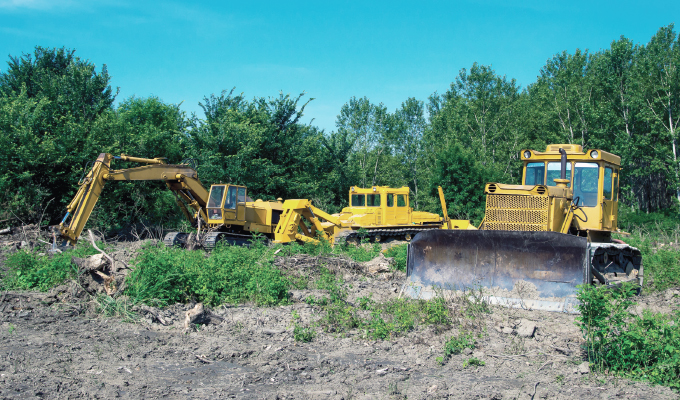By Jane Marsh
Unless you’re working in a developed area, building a new business doesn’t start with laying the foundation. It begins with clearing bushes, trees and other debris from the lot. Land clearing is an integral part of the construction industry, but it can be challenging or even impossible to complete without the right equipment. What do you need to know to choose the best land-clearing equipment for your project? Here are four items to consider:
1. ASSESS THE LOCATION
The first step toward choosing the best land-clearing equipment is appraising the location. Evaluate the lot’s details, from the elevation and grade to the kind and size of trees and other brush that dot the landscape. A flat, relatively level stretch of land will need less modification than one covered in slopes and hills. In the same vein, a bare lot or one with small saplings and bushes growing throughout won’t require the same equipment a heavily forested area might. Take the time to inspect the site before deciding on the type of equipment you might need.
2. DETERMINE THE PROJECT NEEDS
Once you understand the kind of challenges you’ll be facing when clearing a new jobsite, you need to determine what your project will require before you can decide about equipment. Creating an open stretch of land to build a standard foundation will require different tools than digging trenches and getting ready to install an underground pipe system for a geothermal heating and cooling system. It sounds simple enough, but you need to take a step back and determine your project’s exact needs.
3. CONSIDER THE ENVIRONMENTAL IMPACT
Once you’ve completed the first two steps, it can be tempting to dive in headfirst, but there is at least one more thing you’ll need to assess before you can break ground for the first time. You need to consider the problem of habitat destruction. While some demolition is inevitable when creating space to work and build, it is possible, and in many cases, necessary to limit habitat loss to protect the surrounding ecosystems’ delicate balance. There is another layer to preventing habitat destruction: considering the finished structure’s impact. However, that doesn’t play as significant a role in selecting heavy equipment for the beginning of a project.
4. PICK THE RIGHT SIZE FOR THE JOB
Finally, ensure you’re selecting the correctly sized equipment for the job. It’s impractical to assume you can cut down lots of large, old-growth trees with nothing more than a handheld chainsaw. While it is possible, it’s a lot more work than it needs to be. Instead, while you’re working your way through those first steps, figure out what size equipment you’re going to need.
At the same time, you don’t want to bring in the largest piece of machinery in your fleet if it’s too big for the job. You’ll get the task done, but you’ll also end up doing more damage to the surrounding environment than is strictly necessary because of the apparatus’ sheer size. Find that happy middle ground and choose the right size for the job.
CLOSING THOUGHT
You’ll need to go through the steps outlined here each time you prepare to break ground on a new jobsite. Eventually, you’ll develop a process to help streamline your decision-making, but ensure you’re flexible and open to switching things up on the fly. Each new jobsite to clear may present various challenges, but if you have a fundamental idea of how to approach your equipment decision, these obstacles won’t represent any difficulties.
About the author:
Jane is an environmental and green technology writer who covers topics in sustainable construction and green building materials. She also works as the editor-in-chief of environment.co.
Modern Contractor Solutions, February 2021
Did you enjoy this article?
Subscribe to the FREE Digital Edition of Modern Contractor Solutions magazine.



